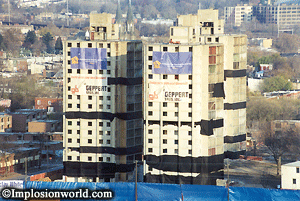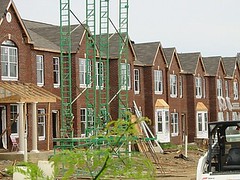Newspapers on Affordable Housing
Lori Montgomery writes for the Post and judging by the types of stories she's been doing, she is focusing on housing and affordability issues. She's been on fire lately, if you ask me, writing some really good stories. Today the Post has another story on Sursum Corda, co-authored by Ms. Montgomery, "Sursum Corda Residents' Faith In Developer's Vision Runs Low " about whether or not the agreement that the co-operative has entered into will really preserve housing options for the people there currently.
 Sursum Corda. Post photo by Michel duCille.
Sursum Corda. Post photo by Michel duCille.Starting with the Sunday edition, the Philadephia Inquirer is doing a three-part series on the impact of revitalizing public housing in Philadelphia, with particular attention to HOPE VI projects. The director of the Philadelphia Housing Authority states that their efforts have been especially significant in revitalizing a number of Philly neighborhoods. (See the PHA "New Look" brochure for their discussion, and images, of their efforts.)
Part One--The New Urban Landscape: The transformation of public housing; Why public housing, once the scourge of the city, now is a vital part of its life and its future.
Part Two--Renewal begets its own problems
 Mill Creek project in Philadelphia. Demolition photos from Implosion World.
Mill Creek project in Philadelphia. Demolition photos from Implosion World. The new Lucien Blackwell Homes on the grounds of the old Mill Creek Public housing project, Philadelphia.
The new Lucien Blackwell Homes on the grounds of the old Mill Creek Public housing project, Philadelphia.If you look at the statistics presented, the new projects have cut by 2/3 the number of dwelling units available to those most in need. And, many of the projects seem to have a suburban style sensibility. By the way, it was my seeing such a project on Girard Avenue in 2003 that really shaped some of my increased stridence about the necessity of urban design in cities, and it led to the op-ed piece that I had in the Philadelphia Daily News, comparing DC to Washington. (Click here for the original, and here for my update of this piece.)
I agree with the need to deconcentrate poverty, but the failure to provide an equivalent amount of housing compared to pre-HOPEVI levels was unnecessary.
Plus, there has been a negative impact on those families that have been displaced. While this is discussed in this journal article: "HOPE VI Relocation: Moving to New Neighborhoods and Building New Ties"; all it is really is a confirmation about the points made in discussion of the "Use Value of Place" in Logan and Molotch Urban Fortunes: A Political Economy of Place almost 20 years ago. Those of lesser means are more reliant on informal social ties and networks. When these networks and ties are broken, the impact is substantive and significant. (Note: Urban Fortunes is a must-read.)



0 Comments:
Post a Comment
<< Home